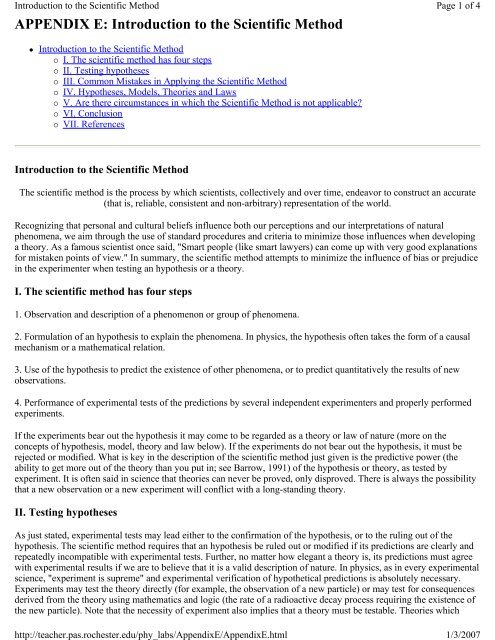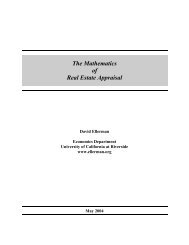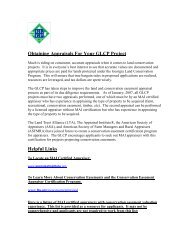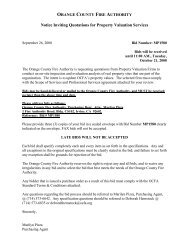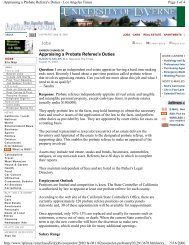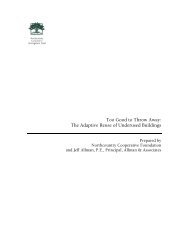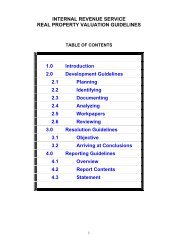APPENDIX E: Introduction to the Scientific Method - The Harris ...
APPENDIX E: Introduction to the Scientific Method - The Harris ...
APPENDIX E: Introduction to the Scientific Method - The Harris ...
You also want an ePaper? Increase the reach of your titles
YUMPU automatically turns print PDFs into web optimized ePapers that Google loves.
http://teacher.pas.rochester.edu/phy_labs/AppendixE/AppendixE.html<br />
1/3/2007<br />
<strong>Introduction</strong> <strong>to</strong> <strong>the</strong> <strong>Scientific</strong> <strong>Method</strong><br />
<strong>APPENDIX</strong> E: <strong>Introduction</strong> <strong>to</strong> <strong>the</strong> <strong>Scientific</strong> <strong>Method</strong><br />
Page 1 of 4<br />
• <strong>Introduction</strong> <strong>to</strong> <strong>the</strong> <strong>Scientific</strong> <strong>Method</strong><br />
◦ I. <strong>The</strong> scientific method has four steps<br />
◦ II. Testing hypo<strong>the</strong>ses<br />
◦ III. Common Mistakes in Applying <strong>the</strong> <strong>Scientific</strong> <strong>Method</strong><br />
◦ IV. Hypo<strong>the</strong>ses, Models, <strong>The</strong>ories and Laws<br />
◦ V. Are <strong>the</strong>re circumstances in which <strong>the</strong> <strong>Scientific</strong> <strong>Method</strong> is not applicable<br />
◦ VI. Conclusion<br />
◦ VII. References<br />
<strong>Introduction</strong> <strong>to</strong> <strong>the</strong> <strong>Scientific</strong> <strong>Method</strong><br />
<strong>The</strong> scientific method is <strong>the</strong> process by which scientists, collectively and over time, endeavor <strong>to</strong> construct an accurate<br />
(that is, reliable, consistent and non-arbitrary) representation of <strong>the</strong> world.<br />
Recognizing that personal and cultural beliefs influence both our perceptions and our interpretations of natural<br />
phenomena, we aim through <strong>the</strong> use of standard procedures and criteria <strong>to</strong> minimize those influences when developing<br />
a <strong>the</strong>ory. As a famous scientist once said, "Smart people (like smart lawyers) can come up with very good explanations<br />
for mistaken points of view." In summary, <strong>the</strong> scientific method attempts <strong>to</strong> minimize <strong>the</strong> influence of bias or prejudice<br />
in <strong>the</strong> experimenter when testing an hypo<strong>the</strong>sis or a <strong>the</strong>ory.<br />
I. <strong>The</strong> scientific method has four steps<br />
1. Observation and description of a phenomenon or group of phenomena.<br />
2. Formulation of an hypo<strong>the</strong>sis <strong>to</strong> explain <strong>the</strong> phenomena. In physics, <strong>the</strong> hypo<strong>the</strong>sis often takes <strong>the</strong> form of a causal<br />
mechanism or a ma<strong>the</strong>matical relation.<br />
3. Use of <strong>the</strong> hypo<strong>the</strong>sis <strong>to</strong> predict <strong>the</strong> existence of o<strong>the</strong>r phenomena, or <strong>to</strong> predict quantitatively <strong>the</strong> results of new<br />
observations.<br />
4. Performance of experimental tests of <strong>the</strong> predictions by several independent experimenters and properly performed<br />
experiments.<br />
If <strong>the</strong> experiments bear out <strong>the</strong> hypo<strong>the</strong>sis it may come <strong>to</strong> be regarded as a <strong>the</strong>ory or law of nature (more on <strong>the</strong><br />
concepts of hypo<strong>the</strong>sis, model, <strong>the</strong>ory and law below). If <strong>the</strong> experiments do not bear out <strong>the</strong> hypo<strong>the</strong>sis, it must be<br />
rejected or modified. What is key in <strong>the</strong> description of <strong>the</strong> scientific method just given is <strong>the</strong> predictive power (<strong>the</strong><br />
ability <strong>to</strong> get more out of <strong>the</strong> <strong>the</strong>ory than you put in; see Barrow, 1991) of <strong>the</strong> hypo<strong>the</strong>sis or <strong>the</strong>ory, as tested by<br />
experiment. It is often said in science that <strong>the</strong>ories can never be proved, only disproved. <strong>The</strong>re is always <strong>the</strong> possibility<br />
that a new observation or a new experiment will conflict with a long-standing <strong>the</strong>ory.<br />
II. Testing hypo<strong>the</strong>ses<br />
As just stated, experimental tests may lead ei<strong>the</strong>r <strong>to</strong> <strong>the</strong> confirmation of <strong>the</strong> hypo<strong>the</strong>sis, or <strong>to</strong> <strong>the</strong> ruling out of <strong>the</strong><br />
hypo<strong>the</strong>sis. <strong>The</strong> scientific method requires that an hypo<strong>the</strong>sis be ruled out or modified if its predictions are clearly and<br />
repeatedly incompatible with experimental tests. Fur<strong>the</strong>r, no matter how elegant a <strong>the</strong>ory is, its predictions must agree<br />
with experimental results if we are <strong>to</strong> believe that it is a valid description of nature. In physics, as in every experimental<br />
science, "experiment is supreme" and experimental verification of hypo<strong>the</strong>tical predictions is absolutely necessary.<br />
Experiments may test <strong>the</strong> <strong>the</strong>ory directly (for example, <strong>the</strong> observation of a new particle) or may test for consequences<br />
derived from <strong>the</strong> <strong>the</strong>ory using ma<strong>the</strong>matics and logic (<strong>the</strong> rate of a radioactive decay process requiring <strong>the</strong> existence of<br />
<strong>the</strong> new particle). Note that <strong>the</strong> necessity of experiment also implies that a <strong>the</strong>ory must be testable. <strong>The</strong>ories which
http://teacher.pas.rochester.edu/phy_labs/AppendixE/AppendixE.html<br />
1/3/2007<br />
<strong>Introduction</strong> <strong>to</strong> <strong>the</strong> <strong>Scientific</strong> <strong>Method</strong><br />
cannot be tested, because, for instance, <strong>the</strong>y have no observable ramifications (such as, a particle whose characteristics<br />
make it unobservable), do not qualify as scientific <strong>the</strong>ories.<br />
If <strong>the</strong> predictions of a long-standing <strong>the</strong>ory are found <strong>to</strong> be in disagreement with new experimental results, <strong>the</strong> <strong>the</strong>ory<br />
may be discarded as a description of reality, but it may continue <strong>to</strong> be applicable within a limited range of measurable<br />
parameters. For example, <strong>the</strong> laws of classical mechanics (New<strong>to</strong>n's Laws) are valid only when <strong>the</strong> velocities of interest<br />
are much smaller than <strong>the</strong> speed of light (that is, in algebraic form, when v/c
http://teacher.pas.rochester.edu/phy_labs/AppendixE/AppendixE.html<br />
1/3/2007<br />
<strong>Introduction</strong> <strong>to</strong> <strong>the</strong> <strong>Scientific</strong> <strong>Method</strong><br />
<strong>the</strong> biases of individuals or groups may cancel out, because experimental tests are repeated by different scientists who<br />
may have different biases. In addition, different types of experimental setups have different sources of systematic<br />
errors. Over a period spanning a variety of experimental tests (usually at least several years), a consensus develops in<br />
<strong>the</strong> community as <strong>to</strong> which experimental results have s<strong>to</strong>od <strong>the</strong> test of time.<br />
IV. Hypo<strong>the</strong>ses, Models, <strong>The</strong>ories and Laws<br />
In physics and o<strong>the</strong>r science disciplines, <strong>the</strong> words "hypo<strong>the</strong>sis," "model," "<strong>the</strong>ory" and "law" have different<br />
connotations in relation <strong>to</strong> <strong>the</strong> stage of acceptance or knowledge about a group of phenomena.<br />
An hypo<strong>the</strong>sis is a limited statement regarding cause and effect in specific situations; it also refers <strong>to</strong> our state of<br />
knowledge before experimental work has been performed and perhaps even before new phenomena have been<br />
predicted. To take an example from daily life, suppose you discover that your car will not start. You may say, "My car<br />
does not start because <strong>the</strong> battery is low." This is your first hypo<strong>the</strong>sis. You may <strong>the</strong>n check whe<strong>the</strong>r <strong>the</strong> lights were left<br />
on, or if <strong>the</strong> engine makes a particular sound when you turn <strong>the</strong> ignition key. You might actually check <strong>the</strong> voltage<br />
across <strong>the</strong> terminals of <strong>the</strong> battery. If you discover that <strong>the</strong> battery is not low, you might attempt ano<strong>the</strong>r hypo<strong>the</strong>sis<br />
("<strong>The</strong> starter is broken"; "This is really not my car.")<br />
<strong>The</strong> word model is reserved for situations when it is known that <strong>the</strong> hypo<strong>the</strong>sis has at least limited validity. A oftencited<br />
example of this is <strong>the</strong> Bohr model of <strong>the</strong> a<strong>to</strong>m, in which, in an analogy <strong>to</strong> <strong>the</strong> solar system, <strong>the</strong> electrons are<br />
described has moving in circular orbits around <strong>the</strong> nucleus. This is not an accurate depiction of what an a<strong>to</strong>m "looks<br />
like," but <strong>the</strong> model succeeds in ma<strong>the</strong>matically representing <strong>the</strong> energies (but not <strong>the</strong> correct angular momenta) of <strong>the</strong><br />
quantum states of <strong>the</strong> electron in <strong>the</strong> simplest case, <strong>the</strong> hydrogen a<strong>to</strong>m. Ano<strong>the</strong>r example is Hook's Law (which should<br />
be called Hook's principle, or Hook's model), which states that <strong>the</strong> force exerted by a mass attached <strong>to</strong> a spring is<br />
proportional <strong>to</strong> <strong>the</strong> amount <strong>the</strong> spring is stretched. We know that this principle is only valid for small amounts of<br />
stretching. <strong>The</strong> "law" fails when <strong>the</strong> spring is stretched beyond its elastic limit (it can break). This principle, however,<br />
leads <strong>to</strong> <strong>the</strong> prediction of simple harmonic motion, and, as a model of <strong>the</strong> behavior of a spring, has been versatile in an<br />
extremely broad range of applications.<br />
A scientific <strong>the</strong>ory or law represents an hypo<strong>the</strong>sis, or a group of related hypo<strong>the</strong>ses, which has been confirmed through<br />
repeated experimental tests. <strong>The</strong>ories in physics are often formulated in terms of a few concepts and equations, which<br />
are identified with "laws of nature," suggesting <strong>the</strong>ir universal applicability. Accepted scientific <strong>the</strong>ories and laws<br />
become part of our understanding of <strong>the</strong> universe and <strong>the</strong> basis for exploring less well-unders<strong>to</strong>od areas of knowledge.<br />
<strong>The</strong>ories are not easily discarded; new discoveries are first assumed <strong>to</strong> fit in<strong>to</strong> <strong>the</strong> existing <strong>the</strong>oretical framework. It is<br />
only when, after repeated experimental tests, <strong>the</strong> new phenomenon cannot be accommodated that scientists seriously<br />
question <strong>the</strong> <strong>the</strong>ory and attempt <strong>to</strong> modify it. <strong>The</strong> validity that we attach <strong>to</strong> scientific <strong>the</strong>ories as representing realities of<br />
<strong>the</strong> physical world is <strong>to</strong> be contrasted with <strong>the</strong> facile invalidation implied by <strong>the</strong> expression, "It's only a <strong>the</strong>ory." For<br />
example, it is unlikely that a person will step off a tall building on <strong>the</strong> assumption that <strong>the</strong>y will not fall, because<br />
"Gravity is only a <strong>the</strong>ory."<br />
Changes in scientific thought and <strong>the</strong>ories occur, of course, sometimes revolutionizing our view of <strong>the</strong> world (Kuhn,<br />
1962). Again, <strong>the</strong> key force for change is <strong>the</strong> scientific method, and its emphasis on experiment.<br />
V. Are <strong>the</strong>re circumstances in which <strong>the</strong> <strong>Scientific</strong> <strong>Method</strong> is not applicable<br />
Page 3 of 4<br />
While <strong>the</strong> scientific method is necessary in developing scientific knowledge, it is also useful in everyday problemsolving.<br />
What do you do when your telephone doesn't work Is <strong>the</strong> problem in <strong>the</strong> hand set, <strong>the</strong> cabling inside your<br />
house, <strong>the</strong> hookup outside, or in <strong>the</strong> workings of <strong>the</strong> phone company <strong>The</strong> process you might go through <strong>to</strong> solve this<br />
problem could involve scientific thinking, and <strong>the</strong> results might contradict your initial expectations.<br />
Like any good scientist, you may question <strong>the</strong> range of situations (outside of science) in which <strong>the</strong> scientific method<br />
may be applied. From what has been stated above, we determine that <strong>the</strong> scientific method works best in situations<br />
where one can isolate <strong>the</strong> phenomenon of interest, by eliminating or accounting for extraneous fac<strong>to</strong>rs, and where one<br />
can repeatedly test <strong>the</strong> system under study after making limited, controlled changes in it.
http://teacher.pas.rochester.edu/phy_labs/AppendixE/AppendixE.html<br />
1/3/2007<br />
<strong>Introduction</strong> <strong>to</strong> <strong>the</strong> <strong>Scientific</strong> <strong>Method</strong><br />
<strong>The</strong>re are, of course, circumstances when one cannot isolate <strong>the</strong> phenomena or when one cannot repeat <strong>the</strong><br />
measurement over and over again. In such cases <strong>the</strong> results may depend in part on <strong>the</strong> his<strong>to</strong>ry of a situation. This often<br />
occurs in social interactions between people. For example, when a lawyer makes arguments in front of a jury in court,<br />
she or he cannot try o<strong>the</strong>r approaches by repeating <strong>the</strong> trial over and over again in front of <strong>the</strong> same jury. In a new trial,<br />
<strong>the</strong> jury composition will be different. Even <strong>the</strong> same jury hearing a new set of arguments cannot be expected <strong>to</strong> forget<br />
what <strong>the</strong>y heard before.<br />
VI. Conclusion<br />
<strong>The</strong> scientific method is intricately associated with science, <strong>the</strong> process of human inquiry that pervades <strong>the</strong> modern era<br />
on many levels. While <strong>the</strong> method appears simple and logical in description, <strong>the</strong>re is perhaps no more complex<br />
question than that of knowing how we come <strong>to</strong> know things. In this introduction, we have emphasized that <strong>the</strong><br />
scientific method distinguishes science from o<strong>the</strong>r forms of explanation because of its requirement of systematic<br />
experimentation. We have also tried <strong>to</strong> point out some of <strong>the</strong> criteria and practices developed by scientists <strong>to</strong> reduce <strong>the</strong><br />
influence of individual or social bias on scientific findings. Fur<strong>the</strong>r investigations of <strong>the</strong> scientific method and o<strong>the</strong>r<br />
aspects of scientific practice may be found in <strong>the</strong> references listed below.<br />
VII. References<br />
1. Wilson, E. Bright. An <strong>Introduction</strong> <strong>to</strong> <strong>Scientific</strong> Research (McGraw-Hill, 1952).<br />
2. Kuhn, Thomas. <strong>The</strong> Structure of <strong>Scientific</strong> Revolutions (Univ. of Chicago Press, 1962).<br />
3. Barrow, John. <strong>The</strong>ories of Everything (Oxford Univ. Press, 1991).<br />
Page 4 of 4<br />
Send comments, questions and/or suggestions via email <strong>to</strong> wolfs@nsrl.rochester.edu.


